THE VILLAGE TIMES



The First American Tycoon-by Richard Smalto
Who was the first American tycoon? Many people familiar with the growth of the American continent say John Jacob Astor. That is incorrect. He was the first tycoon but he was not American. That honor goes to Cornelius Vanderbilt the illiterate boatman from Staten Island or the Commodore Mark Twain called a man without a soul. Astor, a German furrier, bought and sold Manhattan real estate. Vanderbilt built ships and bought railroad cars that transported people all around the world. Vanderbilt was feared, he was envied, he was idolized. Poorly educated a man who could not spell his own name but knew how to make change before he died became the richest man in America.
Vanderbilt quit school when he was eleven and went to work when he was sixteen ferrying passengers between Staten Island and Manhattan in New York harbor. His mother not only taught him how to make change she taught him frugality and the value of hard work. By the end of the war of 1812 he had amassed a small fleet of ships and was ferrying passengers and freight between Boston and the Delaware Bay. Although Vanderbilt kept expanding his shipping business wealth did not buy him respectability.  Uncouth and illiterate he shunned society. At the age of 70 despising ostentation and living a simple life the shipping baron turned his attention to railroads. Integrating fragmented lines he made transportation cost effective. In 1871 before he died, he built a monument to his railroad empire. Among the top ten places visited in the world, it is called GRAND CENTRAL STATION.
Uncouth and illiterate he shunned society. At the age of 70 despising ostentation and living a simple life the shipping baron turned his attention to railroads. Integrating fragmented lines he made transportation cost effective. In 1871 before he died, he built a monument to his railroad empire. Among the top ten places visited in the world, it is called GRAND CENTRAL STATION.
(First published in the Village Times – April 2019, this article bears repeating.)
Eevee’s Story – by Phyllis Woolley
 Hello my peoples! It’s been a while since I have talked to you! I have been busy taking care of mom. She’s getting old, you know, and she isn’t accepting old age gracefully. I am having to remind her to give me my treats. Thank goodness my kibble feeder puts out my meals or I would probably starve to death. The other day I did everything I knew of to get her to give me a treat. I sat by her chair and stared at her, then I slow blinked with both eyes. She said “No!”. Then I gave her a one eyed wink. She said, “All gone!” I knew that was a lie because I could see the treat jar. Then I went into the bathroom and knocked the hand soap into the sink. She said, “No Eevee! I’m going to spank your butt!” By that point, I was getting a little angry. So, I gave her one more chance. I tapped her arm gently and gave her my most loving look. “Eevee, it’s almost time for your lunch! You cannot have a treat!” She had a cup of coffee sitting beside her, so I got in her lap and stood up. Then I put my dirty paw right in her coffee!! “Eevee Michelle”, she screamed! “I cannot believe you did that!” Before she could spank my butt, I ran under the bed where I would be safe. Sure hope that old age thing starts working before my lunch kibble comes out. Maybe she’ll forget!!
Hello my peoples! It’s been a while since I have talked to you! I have been busy taking care of mom. She’s getting old, you know, and she isn’t accepting old age gracefully. I am having to remind her to give me my treats. Thank goodness my kibble feeder puts out my meals or I would probably starve to death. The other day I did everything I knew of to get her to give me a treat. I sat by her chair and stared at her, then I slow blinked with both eyes. She said “No!”. Then I gave her a one eyed wink. She said, “All gone!” I knew that was a lie because I could see the treat jar. Then I went into the bathroom and knocked the hand soap into the sink. She said, “No Eevee! I’m going to spank your butt!” By that point, I was getting a little angry. So, I gave her one more chance. I tapped her arm gently and gave her my most loving look. “Eevee, it’s almost time for your lunch! You cannot have a treat!” She had a cup of coffee sitting beside her, so I got in her lap and stood up. Then I put my dirty paw right in her coffee!! “Eevee Michelle”, she screamed! “I cannot believe you did that!” Before she could spank my butt, I ran under the bed where I would be safe. Sure hope that old age thing starts working before my lunch kibble comes out. Maybe she’ll forget!!
Fishbait – by Frank Howes
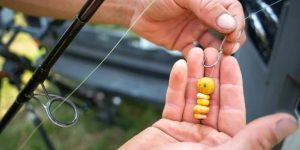 My grandfather was fond of fishing with a cane pole. I grew up following him around to little ponds and creeks around Shoe Heel, North Carolina. One thing that I remember is that it was almost as much fun going after the fishbait as it was to actually catch fish. My grandfather used four different types of fishbait: crickets, worms, wasp grubs, and Catalpa worms. Each required a strenuous effort to procure them.
My grandfather was fond of fishing with a cane pole. I grew up following him around to little ponds and creeks around Shoe Heel, North Carolina. One thing that I remember is that it was almost as much fun going after the fishbait as it was to actually catch fish. My grandfather used four different types of fishbait: crickets, worms, wasp grubs, and Catalpa worms. Each required a strenuous effort to procure them.
We got the crickets by rolling over watermelons in my grandfather’s field. Underneath we found crickets along with the black widow spiders that fed on them. When my grandfather saw the black widow spiders,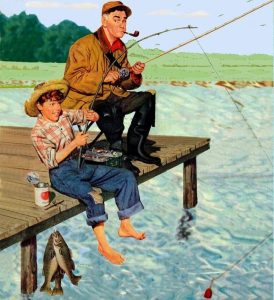 he would say “hold on a minute son,” and he would kill the black widow spiders with his thumb. Once they were dead, he would allow us to scramble after the crickets.
he would say “hold on a minute son,” and he would kill the black widow spiders with his thumb. Once they were dead, he would allow us to scramble after the crickets.
We dug worms from the place where an old outhouse used to be. There are many things that consider a pile of s….. a good environment. Among them are politicians and fishing worms.
We robbed wasp nests for their grubs. My grandfather would knock down a wasp nest with a cane pole. Then he would wait for the wasps to leave and pick up the nest. Inside where the juicy white grubs that fish love so much.
Finally, there were the Catalpa worms. These were the least hazardous to acquire. You simply pulled down the branches on a Catalpa tree, and picked the worms off.
Yes, it was an adventure acquiring fishbait. Almost as much fun as catching the fish!
Summer Vacations I have Taken
The Coldest I’ve ever been
– by Pat Simpson
The coldest I’ve ever been was during summer vacation on the beach, of all places – in North Carolina’s Outer Banks, to be specific – springtime 1992.
I had been retired from IBM for only a few months and decided to enjoy my freedom by taking a long hike – a really long hike. I would hike south from Nags Head, North Carolina to Ocracoke, a distance of about 86 miles (including the Hatteras – Ocracoke ferry ride).
My plan was to take a bus to Nags Head and then hike southwest for about four days on the beach to Ocracoke. I figured that even though I was hiking alone I would be relatively safe because the beach was close to and paralleled by the highway (route 12). Meanwhile, my wife Anne would drive the car and meet me in Ocracoke just in time for an Easter weekend together.
Easter Sunday was April 19 so I left home by bus on April 15. (Timing is everything!) The bus took me east to Greenville and Elizabeth City but I was on my own after that. In those days there was no bus to Nags Head so I took a local taxi service that made regular trips and got there late in the afternoon. It was good to at last find a place to stay overnight and something to eat!
The next morning started out sunny and cheerful. I said a little prayer of thanks and –– with my small backpack – began my trek south. Life was good!
I was still trekking when – after 16 miles – I arrived at the 2.7-mile-long Bonner Bridge, named after politician Herbert C. Bonner. The bridge (now replaced by the new Marc Basnight Bridge, another politician) was a two-lane automobile bridge spanning the Oregon Inlet to Pea Island, my first stop on the Cape Hatteras National Seashore.
I didn’t cross alone…
I was suddenly joined by an unwelcome companion – a powerful rainstorm. The wind began whipping my clothes violently and there was no place to hide from the rain. Even the bridge began to sway ever so slightly.
Where to go? Where to get out of the storm? I hurried to the other side as quickly as I could. There was no town, no gas station. Nothing.
Then I saw a sign.
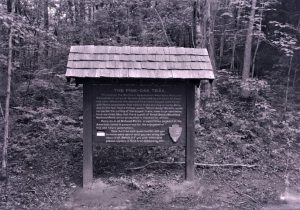 No. Literally. A sign. A real sign. An informational park sign.
No. Literally. A sign. A real sign. An informational park sign.
And it had a rooftop.
So I laid down under the sign – and to some extent I kept relatively dry.
It was getting dark. So I broke out my backpacker’s emergency “space blanket”, a giant sheet of tinfoil or aluminum designed to keep me warm by its very design. First, I wrapped myself in my sleeping bag, then I used the space blanket as the outermost layer to block wind and trap body heat. I became a giant burrito, if you will.
Then I went to sleep.
But not for long.
The wind only grew stronger. It found its way under the sign and continually ripped and tore at my space blanket all night long. I began to shiver – violently. I began to worry that I wouldn’t make it to dawn. But I kept on praying.
 I was shaking all over by the time the sun came up. At dawn’s first light I struggled to my feet, put the sleeping bag and now-shredded space blanket into my backpack with my cold, shaking hands and started walking – fast along the nearby highway – the only way I could think of to warm up.
I was shaking all over by the time the sun came up. At dawn’s first light I struggled to my feet, put the sleeping bag and now-shredded space blanket into my backpack with my cold, shaking hands and started walking – fast along the nearby highway – the only way I could think of to warm up.
The first thing I saw were snowplows. They were plowing sand off the road. The winds last night had fueled massive waves that demolished dunes, exposing homes to the brutal surf. I was lucky to be not only warm, but alive.
So for the next couple of days, I continued my trek. After eating and sleeping my way through quaint villages like Rodanthe, Avon, Buxton and Frisco I took the passenger ferry from Hatteras to Ocracoke – and into the welcoming arms of my wife Anne.
We stayed at the very quaint and old-timey Atlantic Inn and early Sunday went to sunrise services on the beach.
I am so thankful that I didn’t suffer bad side-effects from my stay under the road sign. Later I read that death from the cold can happen even if the body isn’t literally frozen. I was VERY fortunate!
The Last Leaf – by Pat Simpson
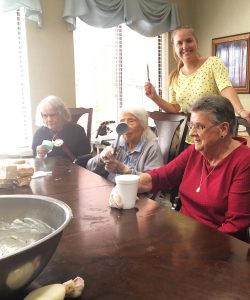
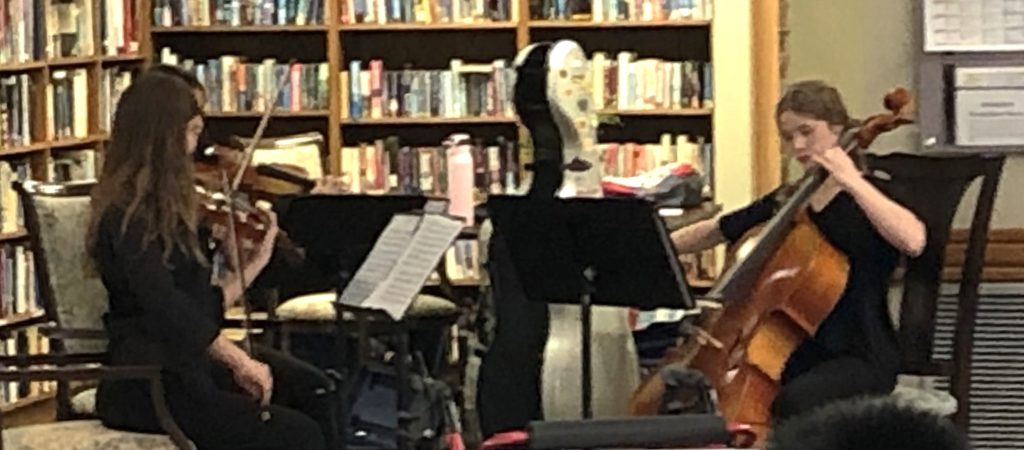
One day, as our cooking club (left) met to create some spinach dip, we heard the sounds of beautiful music; a group of young musicians had come by to brighten our smiles and raise our hopes of joy. It was early September, with so much to be thankful for: no more hurts, no more illness, no more 9/11 events – indeed, our faces already glowed with hopes of joy.
Just outside the window stood a tree – a barren tree, stripped of all its leaves save one. And one leaf was enough to inspire this ode….
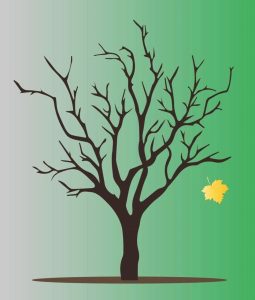 We’ve traveled together since way last spring:
We’ve traveled together since way last spring:
And now we begin a new period in our lives.
We are at the parting of the ways, O leaf.
And soon we’ll travel different paths
As we move into different worlds.
I don’t want to see the last leaf fall
Don’t lose touch, dear leaf,
Don’t lose touch.
My Friend Irma: Jane sees a Ghost
On Wednesday afternoon, September 4, the Independence Village of Olde Raleigh Drama Club held a captive audience of nearly100! My Friend Irma: Jane sees a Ghost included acting AND sound effects! Congratulations on a fantastic production!

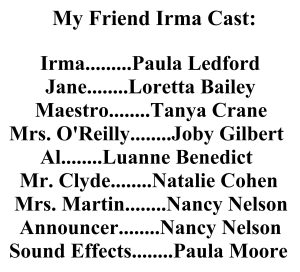
 My Friend Irma was a situation comedy that was so popular that it inspired movies, comic books, and a television program. Marie Wilson was the star of the series in all of its media formats.
My Friend Irma was a situation comedy that was so popular that it inspired movies, comic books, and a television program. Marie Wilson was the star of the series in all of its media formats.
Irma was a pretty and clueless office worker & stenographer attempting to make it on her own in New York with her friend Jane. Each show started with Jane explaining the trouble that Irma had just gotten herself into.